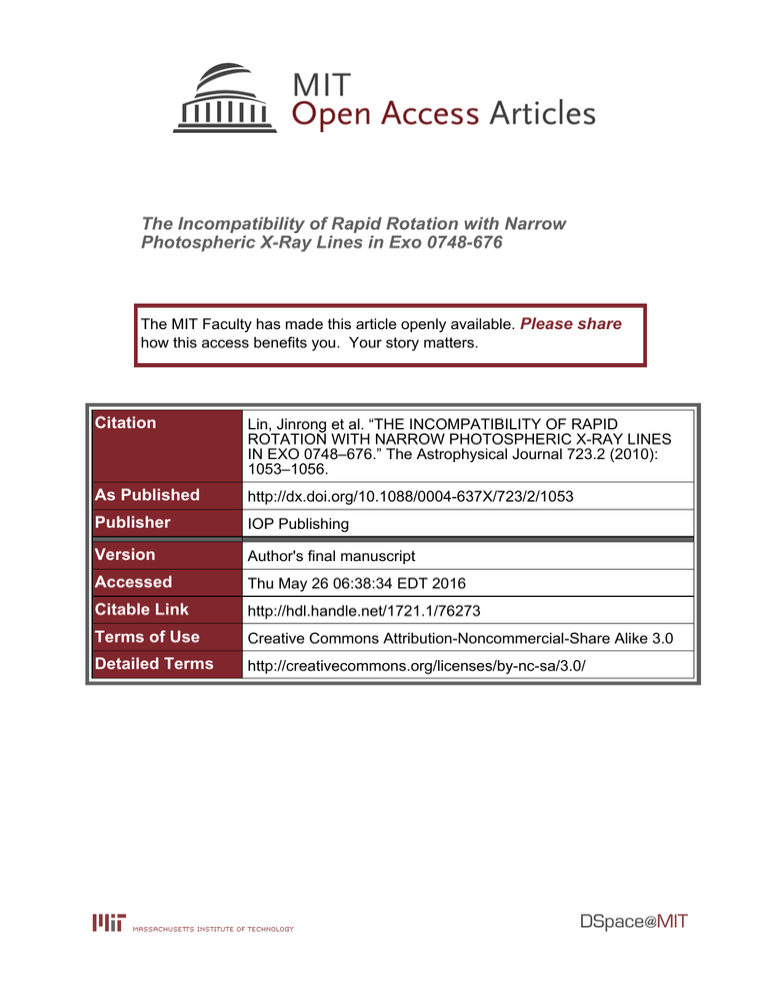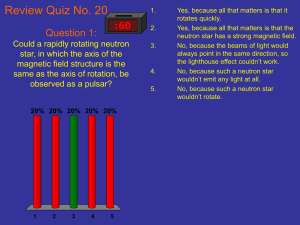The Incompatibility of Rapid Rotation with Narrow Please share
advertisement

The Incompatibility of Rapid Rotation with Narrow Photospheric X-Ray Lines in Exo 0748-676 The MIT Faculty has made this article openly available. Please share how this access benefits you. Your story matters. Citation Lin, Jinrong et al. “THE INCOMPATIBILITY OF RAPID ROTATION WITH NARROW PHOTOSPHERIC X-RAY LINES IN EXO 0748–676.” The Astrophysical Journal 723.2 (2010): 1053–1056. As Published http://dx.doi.org/10.1088/0004-637X/723/2/1053 Publisher IOP Publishing Version Author's final manuscript Accessed Thu May 26 06:38:34 EDT 2016 Citable Link http://hdl.handle.net/1721.1/76273 Terms of Use Creative Commons Attribution-Noncommercial-Share Alike 3.0 Detailed Terms http://creativecommons.org/licenses/by-nc-sa/3.0/ Preprint typeset using LATEX style emulateapj v. 04/20/08 THE INCOMPATIBILITY OF RAPID ROTATION WITH NARROW PHOTOSPHERIC X-RAY LINES IN EXO 0748−676 arXiv:1007.1451v2 [astro-ph.HE] 3 Sep 2010 Jinrong Lin1 , Feryal Özel2 , Deepto Chakrabarty1 , and Dimitrios Psaltis2 ABSTRACT X-ray observations of EXO 0748−676 during thermonuclear bursts revealed a set of narrow (∆λ/λ = 0.018) absorption lines that potentially originate from the stellar photosphere. The identification of these lines with particular atomic transitions led to the measurement of the surface gravitational redshift of the neutron star and to constraints on its mass and radius. However, the recent detection of 552 Hz oscillations at 15% rms amplitude revealed the spin frequency of the neutron star and brought into question the consistency of such a rapid spin with the narrow width of the absorption lines. Here, we calculate the amplitudes of burst oscillations and the width of absorption lines emerging from the surface of a rapidly rotating neutron star for a wide range of model parameters. We show that no combination of neutron-star and geometric parameters can simultaneously reproduce the narrowness of the absorption lines, the high amplitude of the oscillations, and the observed flux at the time the oscillations were detected. We, therefore, conclude that the observed absorption lines are unlikely to originate from the surface of this neutron star. Subject headings: stars:individual(EXO 0748-676) – stars:neutron – X-rays:binaries 1. INTRODUCTION The detection of gravitationally redshifted atomic spectral features from the photospheres of neutron stars has long been recognized as the optimal method for measuring neutron star compactness, hence constraining the equation of state for ultradense matter (Burbidge 1963; van Paradijs 1982; Lewin et al. 1993). There were several reported detections of broad lines in thermonuclear X-ray bursters during the 1980s (Waki et al. 1984; Magnier et al. 1989). However, these observations were made using proportional counters with modest spectral resolution and were difficult to interpret in terms of the expected elemental abundance and ionization profiles of burster atmospheres (Magnier et al. 1989; Madej 1990). Their origin is instead thought to be the instrumental Xe L edge. More recently, Cottam et al. (2002) reported the detection of three narrow X-ray absorption lines in high-resolution X-ray grating spectra of the burster EXO 0748−676 using XMM-Newton. They interpreted these features as atomic transitions of highly ionized iron and oxygen at the neutron star photosphere. The significance of this detection was bolstered by the fact that lines were all consistent with a single gravitational redshift as well as with the observed ionization state and temperature evolution of the burster atmosphere (Cottam et al. 2002; Chang et al. 2005; Rauch et al. 2008). However, the narrowness of the lines (∆λ/λ = 0.018) was surprising given the expectation that most neutron stars in low-mass X-ray binaries are spinning at millisecond periods, which should generally lead to broad line profiles for most geometries (Özel & Psaltis 2003; Chang et al. 2006). Subsequent observations of the burster with the 1 Department of Physics and Kavli Institute for Astrophysics and Space Research, Massachusetts Institute of Technology, Cambridge, MA 02139, USA; jinrongl, deepto@mit.edu 2 Department of Astronomy and Steward Observatory, University of Arizona, 933 N. Cherry Ave., Tucson, AZ 85721, USA; fozel, dpsaltis@email.arizona.edu same instrument failed to confirm these absorption lines (Cottam et al. 2008), although this might be explained by long-term variations in the spectral state of the source (e.g., Krauss 2007). At first, the puzzling narrowness of the detected lines seemed to be explained by the discovery of a weak 45 Hz X-ray oscillation in the summed power spectra of 38 thermonuclear bursts from the Rossi X-ray Timing Explorer (RXTE). This was interpreted as a spin frequency sufficiently slow to give negligible spectral line broadening (Villarreal & Strohmayer 2004). However, Galloway et al. (2010) subsequently detected more powerful 552 Hz oscillations in RXTE observations of two 2007 bursts separated by 11 months. The frequency and amplitude of these oscillations were measured from single bursts, without the need for summing power spectra. The properties of these burst oscillations allow a firm identification of 552 Hz as the spin frequency (Galloway et al. 2010), calling into question the photospheric origin of the absorption lines. Our work is motivated by the suggestion that a carefully chosen geometry could still possibly preserve the interpretation of the absorption lines observed by Cottam et al. (2002). The only way that narrow photospheric absorption lines can be accommodated with a rapid spin frequency is if the neutron star in EXO 0748−676 is viewed nearly pole-on, so that the line-of-sight component of the surface velocity is reduced. Such a configuration, however, will also significantly suppress the amplitude of any burst oscillation generated by a temperature inhomogeneity on the stellar surface. In this paper, we explore this question by calculating the amplitudes of burst oscillations and the width of absorption lines emerging from the surface of a rapidly rotating neutron star. Our aim is to determine whether any combination of neutron-star and geometric parameters can simultaneously reproduce the different X-ray observations of EXO 0748−676: a 552 Hz oscillation at 15% rms amplitude (Galloway et al. 2010) and narrow absorption lines 2 Lin et al. with ∆λ/λ = 0.018 at a gravitational redshift of z = 0.35 (Cottam et al. 2002; Villarreal & Strohmayer 2004). 1.000 2. MODELS 0.100 ∆λ/λ We begin by considering a neutron star rotating at 552 Hz. A gravitational redshift of 0.35 corresponds to a compactness 2GM/Rc2 = 0.45, where M and R are the neutron star mass and radius. Because the width of lines from the neutron star surface depends not only on the ratio M/R but also on the radius itself, we need to specify the M and R that yield the measured gravitational redshift. We choose two pairs of masses and radii: M = 1.4 M⊙ , R = 9.2 km and M = 2 M⊙ , R = 13.1 km. We are interested in generating a pulse amplitude that is at least as large as the observed value of 15% (rms). This is because the intrinsic amplitude can easily be reduced by a number of external effects, but it cannot be amplified. In contrast, for the line widths, we search for configurations that yield line widths that are no broader than the observed value of 0.018. Additional broadening mechanisms can exist, whereas there is no process that can reduce the width beyond the intrinsic rotational broadening we calculate here. In our calculations, we model the exterior spacetime of the rotating neutron star with a Schwarzschild metric but account for the relativistic Doppler boosts and the time delays the photons experience when they are emitted from the rapidly rotating surface. A comparison of this approximation with the results obtained for numerical spacetimes of rotating neutron stars show that the differences in the lightcurves are not very large but that the Schwarzschild-plus-Doppler approximation yields larger pulse amplitudes than do the exact spacetimes (Cadeau et al. 2007). The 552 Hz burst oscillations in EXO 0748−676 were detected in the rise of the bursts, when the propagating burning front is thought to create a short-lived temperature inhomogeneity on the neutron star surface (e.g., Strohmayer et al. 1997). We model the hot region as a single circular hot-spot with angular radius ρ and assume that the rest of the neutron star is dark; this assumption produces the largest rms amplitude in the burst oscillation (Muno et al. 2002). The hot-spot is located at a colatitude α from the “north” rotational pole of the neutron star, taken to vary between 0◦ and 180◦ . The angle between the observer’s line-of-sight and the rotation axis is denoted by β, defined to lie between 0◦ and 90◦ . The light curves and the spectral line shapes also depend on the spectra and the angular distribution of surface emission, which, in turn, are shaped by the neutron star atmosphere (see, e.g., London et al. 1986; Madej 1991). Analyses of the observed burst spectra indicate that they are usually Planckian (e.g., Galloway et al. 2008) and can be adequately modeled as blackbodies. We, therefore, make this assumption in our calculations. We describe the angular distribution of photons emerging from the surface with a Hopf function (Chandrasekhar 1960; DeDeo et al. 2001), which is appropriate for the scattering-dominated neutron star atmospheres during a thermonuclear burst. With this setup, we calculated light curves from hotspots radii of ρ = 5◦ − 45◦ using the algorithm described by Muno et al. (2002), based on the technique outlined in Pechenick et al. (1983) and Miller & Lamb (1998). We ∆ λ / λ = 0.018 0.010 0.001 0.0001 0.0010 0.0100 1− cos β 0.1000 1.0000 Fig. 1.— The minimum fractional width ∆λ/λ of an intrinsically narrow atomic line emitted from the entire surface of a 552 Hz rotating neutron star as a function of 1 − cos β, where β is the angle between the rotation axis of the neutron star and the line-of-sight to an observer at infinity. The two curves show the result for two neutron stars with different masses and radii that correspond to a surface gravitational redshift of z = 0.35. The solid portion of the curves indicates where the β value is consistent with the observed line width limit (∆λ/λ ≤ 0.018; horizontal line) reported by Cottam et al. (2002). Only a small range of β values is consistent with this limit. then calculated the rms amplitudes of the oscillations. The choice of small angular sizes of the hot-spot maximizes the amplitude of the flux oscillations that can be observed from the neutron star. In the next section, we will also need to ensure that the phase-averaged brightness of these hot-spots is sufficient to generate the observed flux at the time when the burst oscillations were detected. We, therefore, calculated the phase-averaged luminosity from each spot using equation (1) of Psaltis et al. (2000). In order to convert this luminosity to a flux, we need an estimate of the distance to EXO 0748−676. Even though spectroscopic estimates for the distance to this source place it at & 7−9 kpc (Özel 2006; Boirin et al. 2007), we adopt here a very conservative lower limit of 3 kpc in order to demonstrate that our results depend very weakly on the assumed distance. We calculated the spectral line broadening using the same formalism and approach discussed in Özel & Psaltis (2003). Relativistic Doppler boosts cause an asymmetry in the spectral line profiles in addition to broadening them, while the strong gravitational lensing effect alters the relative contribution of surface elements with different line-of-sight velocities to the line profile. We take the input spectrum to be a Gaussian line with negligible intrinsic width. We define ∆λ as the full-width half-maximum of the output spectral feature and the broadening of the spectral line as ∆λ/λ. Note that the absorption lines were detected in the cooling tail of the bursts, when the emission comes from the entire surface of the neutron star rather than a localized hot spot. Thus, the spectral width will depend on the observer’s inclination β but not on the hot-spot colatitude α. EXO 0748−676 1.0000 1.0000 rms > 15% rms > 15% 0.1000 1 - cos β 0.1000 1 - cos β 3 0.0100 0.0100 ∆ λ / λ < 0.018 ∆ λ / λ < 0.018 0.0010 0.0001 -1.0 0.0010 -0.5 0.0 cos α 0.5 1.0 Fig. 2.— Constraints on the inclination angle β of an observer at infinity and on the colatitude α of a localized emission region on the neutron star surface responsible for the burst oscillations during the rise phase of X-ray bursts for EXO 0748−676. The rectangular hatched region shows the limit on the observer’s inclination imposed by the narrow widths of the absorption lines reported by Cottam et al. (2002). The gray shaded region shows the constraints imposed by the 15% (rms) burst oscillation amplitude reported by Galloway et al. (2010) and the phase-averaged flux observed during the oscillations. Both calculations were performed for a hot-spot radius of 5◦ on a neutron star with a mass of 1.4 M⊙ and a radius that corresponds to a surface gravitational redshift of z = 0.35. There are no pairs of inclination and colatitude angles that are simultaneously consistent with both constraints. 3. RESULTS We present here the constraints the two observations impose on the geometry of the system for the value of the gravitational redshift of z = 0.35 inferred by Cottam et al. (2002). Figure 1 shows the fractional width of an intrinsically narrow atomic line emitted from the entire surface of the neutron star, as a function of the cosine of the observer’s inclination β. As expected, the line broadening due to rotation scales roughly as the non-relativistic expression ∆λ 2ΩR ≃ sin β λ c ν R 1/2 s = 0.21 . (1) 1 − cos2 β 552 Hz 9.2 km As the angle β decreases (and hence 1 − cos β also decreases), the projection of the rotation velocity along the line of sight also decreases, causing the rotational broadening of the line to be substantially reduced. For a neutron star of 1.4 M⊙ , the observed upper limit of ∆λ/λ ≤ 0.018 (Villarreal & Strohmayer 2004) on the fractional width of the lines reported by Cottam et al. (2002) can be satisfied only if cos β & (1 − 2.6 × 10−3) or, equivalently, if the observer’s inclination is within 4.1◦ from the rotation axis of the neutron star. The posterior chance probability that we are observing the neutron star in EXO 0748−676 within 4.1◦ of its rotation axis is exceedingly small. Assuming a random distribution in the orientation of observers in the sky, i.e., a distribution that is flat in cos β, leads to a chance probability of ≤ 2.6 × 10−3 . More importantly, as we show below, such a face-on orientation of the system is inconsistent with the ≥ 15% amplitudes of burst oscil- 0.0001 -1.0 -0.5 0.0 cos α 0.5 1.0 Fig. 3.— Same as Figure 2 for a neutron star with a mass of 2 M⊙ and a radius that corresponds to a surface gravitational redshift of z = 0.35. lations reported by Galloway et al. (2010) in the same source. Figure 2 shows the constraint on the inclination angle β of the observer and the colatitude α of the hot emitting region that gives rise to the burst oscillations during the rise phase of X-ray bursts. This constraint is obtained by imposing two requirements (see Psaltis et al. 2000): The rotating hot spot should produce oscillations with an rms amplitude of at least 15% and the phase averaged flux in the 2.5−25 keV range should be larger than 3×10−10 erg s−1 cm−2 , observed at the time when the oscillations were detected (Galloway et al. 2010). The first requirement constrains the observer’s inclination β and the colatitude of the spot α to be away from the rotational pole of the star. The second requirement excludes nearly antipodal orientations between the observer and the hot-spot, in which case the spot is almost completely hidden from view. These two requirements can be met in the light gray shaded region, i.e., only when the inclination of the observer is β > 11◦ , such that (1 − cos β) > 2 × 10−2 . If the inclination of the observer is smaller than this value or the colatitude of the emitting region is close to zero, then the amplitude of the burst oscillations is reduced below the detected value. If, on the other hand, the colatitude of the hot-spot is & 55◦ , so that cos α . 0.6, then the rms amplitudes can be very large but the phase-averaged flux goes to zero. In our calculations, we assume that all of the emission originates from the hot spot. Taking into account any emission from the rest of the neutron star, at a lower temperature, may help increase the observed flux, but this would also significantly reduce the pulse amplitude that can be detected. The hatched region shows the area of the parameter space that is consistent with the width of the narrow lines reported by Cottam et al. (2002). As discussed earlier, this places a constraint only on the observer’s inclination β because the entire neutron star is expected to emit during the cooling tails of the bursts when the lines were detected. Figure 2 demonstrates, therefore, that the narrow width of the reported atomic lines is inconsistent with the observed amplitudes of the burst oscillations for any emission geometry and observer orientation with 4 Lin et al. 1.0000 rms > 15% 1 - cos β 0.1000 0.0100 ∆ λ / λ < 0.018 0.0010 0.0001 -1.0 -0.5 0.0 cos α 0.5 1.0 Fig. 4.— Same as Figure 2 for a hot-spot radius of 45◦ . respect to the rotation axis of the neutron star. The particular constraints shown in Figure 2 depend on the mass of the neutron star as well as the angular size of the hot-spot. Increasing the mass while keeping the redshift the same results in a neutron star with a larger radius. This causes the constraint imposed by line broadening to be even stricter (see Fig. 1 and eq. [1]), and the observed flux for a given angular spot size to be larger. Figure 3 shows these effects for a 2.0 M⊙ neutron star and demonstrates that even though the individual constraints change, there is still no part of the parameter space that is consistent with both requirements. Increasing the size of the hot-spot does not change this conclusion either. We show in Figure 4 the allowed regions of the parameter space calculated for a hot-spot radius of 45◦ . Even though a larger range of hot-spot colatitudes can generate the observed flux, the larger size of the hot-spot substantially reduces the amplitude of oscillations (especially at the antipodal orientations between the hot-spot and the observer), thus limiting further the observer’s inclination. The combination of these two effects leaves again no region of the parameter space that is consistent with the width of the atomic lines. We also considered possible uncertainties in the timing measurement. Our calculations show that no region of the parameter space is allowed unless the rms amplitude is smaller than 7%. Such a small value of the amplitude is excluded by the timing observations at more than a 4σ level. Along the same lines, we explored the possibility that the detected 552 Hz burst oscillation is at the second harmonic of the spin frequency of the neutron star. We verified that there is still no combination of parameters that is consistent with both requirements, even without including the further geometrical constraints that are necessary to make the second harmonic stronger than the fundamental. Finally, our conclusion depends rather weakly on the identification of the reported spectral features with particular atomic lines and hence on the assumed gravitational redshift from the surface of the neutron star. Rauch et al. (2008) identified the observed spectral features in EXO 0748−676 with a different set of atomic transitions and concluded that the gravitational redshift from the neutron star surface is z = 0.24. We repeated the above calculations for this value of the redshift and found again that no region of the parameter space is simultaneously consistent with both observations. We, therefore, conclude that the lines reported by Cottam et al. (2002) are unlikely to originate from the photosphere of this neutron star. As a result, any inference of the neutron star mass and radius based on this redshift measurement (e.g., Özel 2006) is not tenable. J.L. and D.C. acknowledge support from the NASA Astrophysics Data Program. FÖ acknowledges support from NSF grant AST 07-08640 and Chandra Theory grant TMO-11003X. DP was supported by the NSF CAREER award NSF 0746549 and Chandra Theory grant TMO-11003X. REFERENCES Boirin, L., Keek, L., Méndez, M., Cumming, A., in’t Zand, J. J. M., Cottam, J., Paerels, F., & Lewin, W. H. G. 2007, A&A, 465, 559 Burbidge, G. 1963, ApJ, 137, 995 Cadeau, C., Morsink, S. M., Leahy, D., & Campbell, S. S. 2007, ApJ, 654, 458 Chandrasekhar, S. 1960, Radiative transfer (New York: Dover, 1960) Chang, P., Bildsten, L., & Wasserman, I. 2005, ApJ, 629, 998 Chang, P., Morsink, S., Bildsten, L., & Wasserman, I. 2006, ApJ, 636, L117 Cottam, J., Paerels, F., & Mendez, M. 2002, Nature, 420, 51 Cottam, J., Paerels, F., Méndez, M., Boirin, L., Lewin, W. H. G., Kuulkers, E., & Miller, J. M. 2008, ApJ, 672, 504 DeDeo, S., Psaltis, D., & Narayan, R. 2001, ApJ, 559, 346 Galloway, D. K., Lin, J., Chakrabarty, D., & Hartman, J. M. 2010, ApJ, 711, L148 Galloway, D. K., Muno, M. P., Hartman, J. M., Psaltis, D., & Chakrabarty, D. 2008, ApJS, 179, 360 Krauss, M. I. 2007, PhD thesis, , Dept. of Physics, Massachusetts Inst. of Technology (2007) Lewin, W. H. G., van Paradijs, J., & Taam, R. E. 1993, Space Science Reviews, 62, 223 London, R. A., Taam, R. E., & Howard, W. M. 1986, ApJ, 306, 170 Madej, J. 1990, Acta Astronomica, 40, 223 —. 1991, ApJ, 376, 161 Magnier, E., Lewin, W. H. G., van Paradijs, J., Tan, J., Penninx, W., & Damen, E. 1989, MNRAS, 237, 729 Miller, M. C., & Lamb, F. K. 1998, ApJ, 499, L37+ Muno, M. P., Özel, F., & Chakrabarty, D. 2002, ApJ, 581, 550 Özel, F. 2006, Nature, 441, 1115 Özel, F., & Psaltis, D. 2003, ApJ, 582, L31 Pechenick, K. R., Ftaclas, C., & Cohen, J. M. 1983, ApJ, 274, 846 Psaltis, D., Özel, F., & DeDeo, S. 2000, ApJ, 544, 390 Rauch, T., Suleimanov, V., & Werner, K. 2008, A&A, 490, 1127 Strohmayer, T. E., Zhang, W., & Swank, J. H. 1997, ApJ, 487, L77 van Paradijs, J. 1982, A&A, 107, 51 Villarreal, A. R., & Strohmayer, T. E. 2004, ApJ, 614, L121 Waki, I., et al. 1984, PASJ, 36, 819




